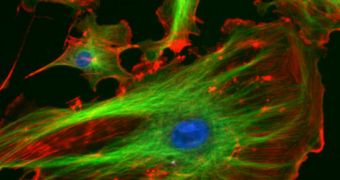A group of investigators from the National University of Ireland (NUI) says that two types of genes which date back more than 1.5 billion years ago tend to remain separate even now, after living together for such a long time. They interact only minimally, and generally stay out of each other's ways.
These two gene networks have been mingling inside the cells of countless species, including our own, for more than a third of the planet's history, and yet they apparently could not find any way to merge.
That is not to say that they are in competition – they simply do not interact, either for good or for worse. Experts plastically refer to our cells as chimeras, ancient fusions of unrelated creatures that somehow come together in a working whole.
We (and many other species) inherited these gene networks from two kinds of simple cells that merged eons ago to form eukaryotes. Before they came together, these organisms did not have a cell nucleus or a cellular membrane to shield them from their environment.
All modern cell machinery are based on these separate “communities” of genes, which collaborate to keep the cell going. However, biologists say, they interact only if they absolutely have to.
“We humans, as part of the eukaryotes, we’re still a community of two prokaryotes,” explains NUI biologist James McInerney. He is the coauthor of a new study detailing the findings, which is published in the July 27 issue of the esteemed scientific journal Genome Biology and Evolution.
At this point, there are two main lines of thought seeking to explain how prokaryotes evolved into eukaryotes. One says that the process took place directly, whereas the other holds that archaebacteria and eubacteria cells merged with each other in order to create the more complex organism.
After this was achieved, cells suddenly experienced a boost in function, with various internal tasks being delegated to structures called organelles. Each of these got more and more specialized, and this lead to an increase in size over time, Wired reports.
“This idea is a hundred years old But we wanted to ask, ‘If you have two types of organisms coming together to form a new kind of cell, do their metabolisms become completely blended together? What happens when genomes fuse'?” McInerney asks.
The team conducted a series of molecular analyses on proteins that were coded for by genes in either of the communities. McInerney and his NUI colleague David Alvarez-Ponce determined that these molecules interact almost exclusively with proteins in their group.
“They’ve found an imprint of this original symbiosis remaining after 1.5 billion years. This is a brilliant discovery. You would have thought someone would have noticed this, but nobody ever did,” concludes Heinrich-Heine-Universität Düsseldorf endosymbiosis researcher Bill Martin.

 14 DAY TRIAL //
14 DAY TRIAL //